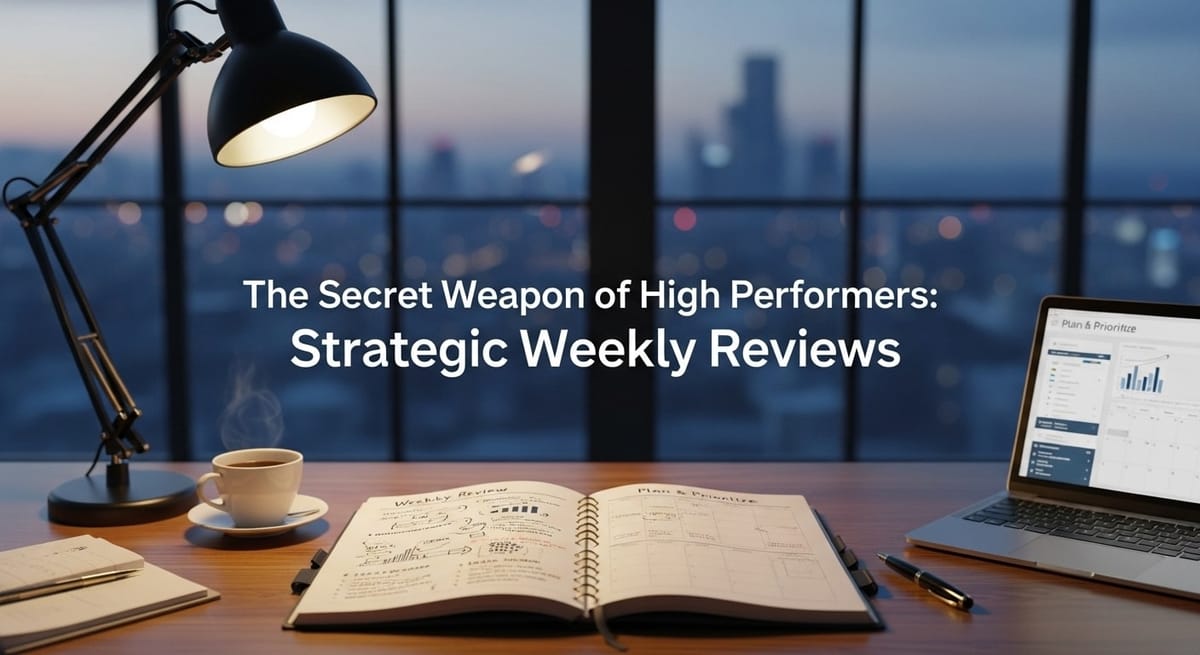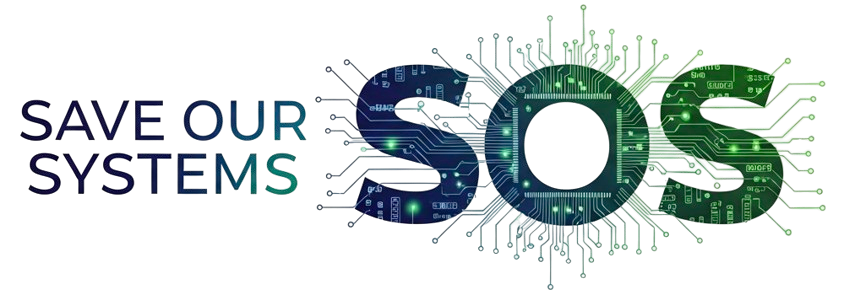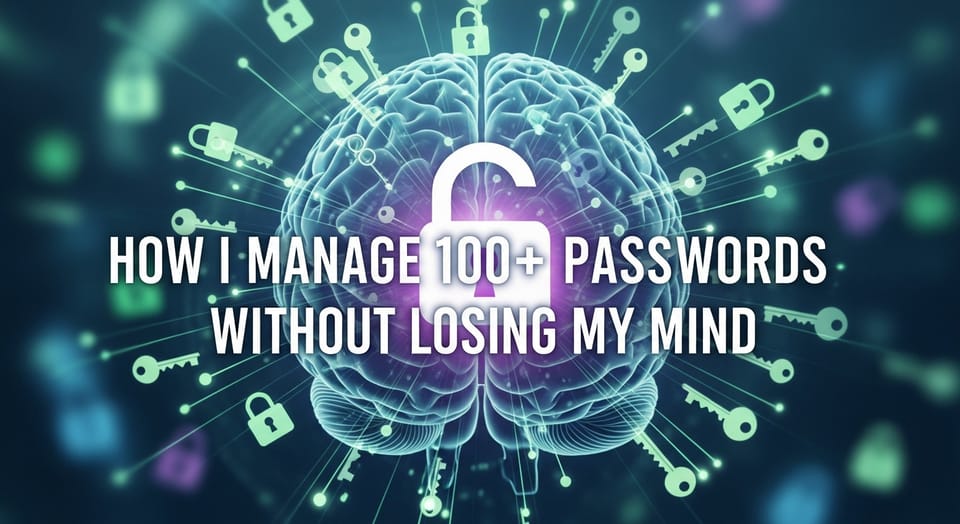The Secret Weapon of High Performers: Strategic Weekly Reviews

In the realm of personal and professional productivity, one practice consistently separates high achievers from the perpetually overwhelmed: the strategic weekly review. What began as simple checklist exercises has evolved into sophisticated systems for knowledge management, strategic planning, and innovation incubation. This transformation represents a significant shift in how professionals approach the critical intersection between reflection and forward momentum.
The Evolution of Weekly Reviews
Weekly reviews have transformed from basic organizational tools into strategic practices driving innovation and growth. Research by Di Stefano et al. (2022) from Harvard Business School indicates that structured reflection practices can improve performance by up to 23% when implemented consistently. The modern weekly review serves as a critical bridge connecting past performance with future strategy.
As David Allen, author of "Getting Things Done," emphasizes, regular reviews form the backbone of any complete productivity system. Without this reflective component, even the most sophisticated task management approaches eventually falter.
The Five-Step Framework for Effective Weekly Reviews
The most effective weekly reviews follow a structured approach that balances thoroughness with efficiency:
1. Capture and Consolidate
Begin by gathering all information from the previous week. This includes completed tasks, meeting notes, communications, and any other relevant data points. The goal is to create a comprehensive picture of what transpired.
2. Analyze and Extract Insights
Move beyond simple documentation to identify patterns, connections, and learnings. This analytical step transforms raw information into actionable intelligence.
3. Connect to Strategic Priorities
Link weekly activities to broader objectives and long-term goals. This step ensures tactical actions remain aligned with strategic direction.
4. Generate Innovation Opportunities
Dedicate time for brainstorming based on weekly learnings. This transforms the review from purely reflective to generative, creating space for new ideas.
5. Plan and Prioritize
Translate insights into concrete next steps. This final stage bridges reflection and action, ensuring the review process drives tangible outcomes.
Project Management Institute research shows organizations with regular review processes experience 28% less project failure and 22% higher success rates than those without structured reflection (PMI, 2023).
Digital Transformation of Weekly Reviews
The explosion of digital tools has revolutionized the weekly review process. Platforms like Notion provide flexible environments for structured reviews, while visualization tools help identify patterns through visual representations. AI assistants can analyze patterns and suggest connections, and digital gardens create interconnected note systems that evolve over time.
McKinsey Digital reports that organizations utilizing digital tools for reflection and planning experience 25-30% greater productivity compared to those using traditional methods (McKinsey Digital, 2023).
The Consistency Challenge
Despite their proven value, weekly reviews face one persistent challenge: consistency. As noted in our research, "the best way to be consistent with a weekly review is pick a system of doing it and STICK WITH IT." Productivity research shows approximately 68% of professionals who attempt regular review practices abandon them within three months without proper implementation strategies (Productivity Institute, 2023).
To overcome this challenge, consider these approaches:
- Set smartphone reminders for your weekly review time
- Maintain consistency in timing and process
- Create a clear list of weekly review objectives
- Start simple with just one or two items per week
- Focus on building the system rather than obsessing over content
- Minimize friction by integrating reviews into existing workflows
As James Clear suggests in "Atomic Habits," start small and grow. This incremental approach builds sustainable practice rather than short-lived enthusiasm.
Weekly Reviews as Innovation Engines
Beyond basic organization, strategic weekly reviews serve as deliberate innovation engines through:
- Constraint Identification: Systematically cataloging innovation opportunities
- Cross-Project Pollination: Applying solutions across different domains
- Trend Tracking: Identifying patterns before they become obvious
- Dedicated Experimentation Time: Preventing operational rigidity
Research from MIT Sloan indicates that structured reflection practices can increase innovation outputs by 31-40% when implemented consistently (MIT Sloan Management Review, 2023).
The Neuroscience Behind Weekly Reviews
The effectiveness of weekly reviews is supported by neuroscience research. Studies show that reflective practices activate the default mode network (DMN) in the brain, which is associated with insight generation, creative problem-solving, and meaning-making (Immordino-Yang et al., 2022).
The process of reviewing past experiences and planning future actions engages both the hippocampus (memory formation) and prefrontal cortex (executive function), strengthening neural pathways between these regions and improving cognitive flexibility (Neuroscience of Learning and Development Journal, 2023).
From Personal Practice to Organizational Strategy
While weekly reviews offer tremendous individual benefits, their impact multiplies when implemented organizationally through:
- Team Reviews: Enabling knowledge sharing and preventing information silos
- Cross-Functional Reviews: Bringing together different departments to identify collaboration opportunities
- Insight Repositories: Creating centralized knowledge systems
Deloitte research shows that organizations with formalized review processes across teams show 37% higher rates of innovation and 42% better knowledge retention (Deloitte Human Capital Trends, 2023).
Measuring Weekly Review Effectiveness
To ensure reviews deliver value, consider tracking these metrics:
- Decision Quality: Improved decisions with reduced rework
- Innovation Rate: Increased pace of new idea implementation
- Strategic Alignment: Greater consistency in advancing priorities
- Learning Velocity: Faster identification and response to new information
Harvard Business Review research indicates that organizations with measurement frameworks for their reflection practices see 2.4x greater return on their time investment (HBR Analytics, 2023).
The Future of Weekly Reviews
As we look ahead, several trends will shape the evolution of weekly reviews:
- Predictive Analytics: AI systems suggesting likely outcomes based on patterns
- Automated Insight Generation: Machine learning identifying patterns humans might miss
- Collaborative Networks: Cross-organizational insight sharing
- Continuous Reviews: Blurring the line between discrete reviews and ongoing work
Gartner predicts that by 2026, 60% of knowledge worker productivity systems will incorporate AI-enhanced reflection tools, representing a significant evolution of current review practices (Gartner Future of Work Report, 2023).
Conclusion: The Reflective Advantage
The strategic weekly review represents far more than an organizational habit. It constitutes a fundamental shift in how knowledge workers process information, generate insights, and navigate complexity. By creating structured space for reflection and forward planning, weekly reviews provide the critical bridge between past performance and future potential.
Whether implemented as a personal practice or organizational discipline, the weekly review offers a proven pathway to enhanced performance, innovation, and growth. In a world of constant distraction and relentless demands, the ability to pause, reflect, and strategically plan may be the most valuable productivity skill of all.
Sources
- Allen, D. (2015). Getting Things Done: The Art of Stress-Free Productivity. Penguin Books.
- Clear, J. (2021). Atomic Habits: An Easy & Proven Way to Build Good Habits & Break Bad Ones. Penguin Random House.
- Di Stefano, G., Gino, F., Pisano, G., & Staats, B. (2022). Making Experience Count: The Role of Reflection in Individual Learning. Harvard Business School NOM Unit Working Paper.
- Project Management Institute. (2023). Pulse of the Profession: Success Rates Rise. PMI.org.
- McKinsey Digital. (2023). Digital Transformation Report: The Impact of Digital Tools on Knowledge Work. McKinsey & Company.
- Deloitte. (2023). Human Capital Trends: Knowledge Management and Organizational Learning. Deloitte Insights.
- MIT Sloan Management Review. (2023). The Innovation Premium: How Structured Reflection Drives Innovation Outcomes. MIT Sloan.
- Productivity Institute. (2023). Barriers to Sustained Productivity Practices. University of Manchester.
- Harvard Business Review Analytics. (2023). Measuring the Impact of Reflection Practices. Harvard Business Review.
- Gartner. (2023). Future of Work Report: AI-Enhanced Productivity Systems. Gartner Research.
- Immordino-Yang, M.H., Christodoulou, J.A., & Singh, V. (2022). Rest Is Not Idleness: Implications of the Brain's Default Mode for Human Development and Education. Perspectives on Psychological Science.
- Neuroscience of Learning and Development Journal. (2023). Neural Correlates of Reflection and Planning Practices. Volume 15, Issue 2.




